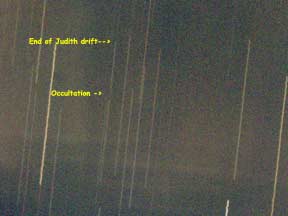The Judith Occultation of Mag 11.5 Star
Jan 17/18, 2014
Like other events this month, Cabrillo Observatory's confined to a drift scan image for doing asteroid occultations. This one had good odds, as Aptos was on the predicted southern limit with rank 74. I arrived at the observatory at 10pm, oblivious to the fact that at that moment Judith was passing in front of a magnitude 13.1 star from also somewhere in the Bay Area. Ted Swift in Davis had a miss for both events. Predicted time for me was 7:04:42 UT. Cabrillo Observatory was on track -41S.
I opened up the dome, fired up the computer, got the G11 mount pointed in the right direction, in Cancer, identified the target, and then did some test exposures while bringing up the live Australian Open Tennis slamtracker on the web. The target was only 11.5 magnitude, and looked on the test exposure to be an F or G type spectral type. I was worried the 96% moon which was only 13 degrees away and also in Cancer, would make the sky so bright that a long exposure would wreck the sky background. The moon definitely didn't help, but it looked to be do-able. I doubt the mag 13.1 event was do-able by this star trail method however.
My procedure is: put CCDOPS in 'focus' mode for identifying the field and target, then click off the "track" button to verify which direction the star will trail into. Then I'll position the target star near the boundary edge such that I can get a long trail entirely on the chip. I'll tell CCDOPS to initiate a "grab" with dark frame set to NONE, and then position the click-to-start-exposure button right next to the Gemini rainbow icon's "track" button, and wait for the right moment. I click off "track" and within a couple of seconds, initiate the exposure while watching the second tick on my digital watch. Prior, I'll have looked at my digital watch and also the NIST time widget on the computer LCD screen and estimated the offset in time between the two. In this case, my watch was ahead by about 0.28 seconds from the NIST monitor. Now, the widget said the network delay was 0.1 second. What the NIST site does not say is - is the time shown corrected for this offset?
The dark-subtracted, flat-field corrected color .tif file of the star trail is here. will work on it later this weekend.

The exposure was 50 seconds long, trailing from the bottom to the top. The start was 7:04:19.9 (eye/ear trying to start it on the 20 second mark and noticing when I actually heard the keyboard click), and immediately the exposure progression graphic came up w/o apparent delay. The NIST time widget on my computer gave the live time, and stated the delay loop was 0.1 second. It is not obvious whether this 0.1 second is corrected in the display time, or whether one should assume the true time is 0.1 second later than the widget display time (anyone know?). I've sent an email asking this question to the NIST people on 1/20/14. |
|
|
|
|
Derek had a successful video timing of this occultation as well, from track -24km south. Congratulations, Derek! His page is here. Derek's D: 7:04:49.123, R: 7:04:52.157 from north of me. That means the asteroid must have moved at least half a diameter or a little more to the south.
Mine, from -41km south...
Start: 7:04:19.9 y=pixel 1012
D:......................... y=pixel 558
->29.23 sec after start
R:......................... y=pixel 492 -> 33.46 sec after start
End: 7:05:09.9 y=232
0.064 seconds per pixel
Occultation duration: 4.23 seconds
If the start was 7:04:19.9 (meaning the 0.1sec delay in the NIST time widget was already reflected in the widget display time, then the timings are:
D: 7:04:49.13 +- 0.15sec
R: 7:04:53.36
+- 0.15sec
The Excel report form, filled out and sent to Brad Timerson on 1/20/14 is here.
